My journey started with Delta flight #114 departing Atlanta at 5:45 pm EDT heading nonstop toward Barcelona. Unfortunately, because the flight was nearly full when I purchased my ticket, I was in the middle of the middle row. In simple language- I didn’t have an aisle seat. At least I was in the Comfort section, not in the cattle car labeled euphemistically as “economy.” Sill, I can’t remember the last time I didn’t have an aisle. Space is very important to me. The preceding is a profound statement, as this flight demonstrated why I hope to never again become stuck in the middle of a 4-wide row. The ladies to my left didn’t shut up for the first 2 hours. And they talked LOUD- and about nothing that was ever interesting to overhear. The girl in her young 20s to my right was OK. Yet, regardless of her merits, I prefer the open space of an aisle and not having to ask anybody to get up when I need to use the restroom.
Nevertheless, overall the flight was tolerable- for an airline flight- in other words, a big tin can with wings that basically immobilizes us for hours while we remain frustrated and sedentary. The pleasant part that made the flight tolerable, despite having the 2 women auditioning for “The View” adjacent to me, was that I had the opportunity to watch 2 excellent movies and the in-flight dinner was surprisingly tasty.
“Sleepless,” starring Jamie Foxx and Michelle Monaghan, had nonstop action and some nice, although mostly predictable, plot twists. I know that “Sleepless” was panned by the critics as a formulaic car chase, gunfight, dirty cop movie. However, from my perspective the formula worked. Moreover, it was a great airplane movie- meaning for 2 hours I easily escaped the trapped feeling of confinement and loss of freedom associated with flying.

Next, I watched “The Founder,” starring Michael Keaton. Keaton was awesome, as was the movie! “The Founder” is the adapted true story of Ray Koc’s founding of the McDonald’s Corporation. Kroc’s prior failures, his recognition of the genius of the McDonald brothers’ burger preparation process, his recognition of the appeal of the McDonald’s name, his persistence to succeed, and his willingness to engage in conflict to achieve his goals told an intriguing business success story. Although I personally try to eat healthy and stay clear of McDonald’s, I have tremendous respect for McDonald’s as the #1 restaurant chain in the world- and a major landowner.
I also started to watch another movie, “Wilson,” starring Woody Harrelson. However, I couldn’t get into the film and turned it off after just 10 minutes. “Wilson” was not a good airplane movie. On the plane “a movie has gotta move.” Harrelson’s character was more annoying than entertaining and the movie progressed too slowly. Airplane movies need to have impact, or else I will just fall asleep- or worse, I will stay awake and dwell on the fact that for several more hours and time zones I will remain packed like a sardine in a tin can next to aspiring cast members of “The View.”
Regarding Delta’s dinner selection, I was credulous after reading a recent article in the AJC business section that claimed Delta hired a new chef whose goal was to revamp the in-flight menu so that the food would appeal to passengers. Fortunately, I experienced a surprise even more pleasant than if Delta gave me permanent PreCheck status without requiring me to drive to the airport for an interview. Delta should give the chef a raise. The chicken dish with broccoli was excellent. I couldn’t believe it! After eating the exquisite main course and vegetable I was disappointed that the accompanying salad and dessert was nowhere equivalent. Yet, the salad and dessert were certainly edible.
The only big negative was the confined, strident ambience of eating on a small tray table with yakking ladies to my left and a person to my right that prevented me from escaping the Chatty Kathys. I am accustomed to spreading my elbows and having ample space when eating. In contrast, maneuvering within the perimeter of a small tray table requires the acrobatic skills of a contortionist. Maybe next time I fly across the pond I will splurge and buy one of the more spacious business class seats that look like cubicles.
After almost 9 hours the plane landed the next day, Thursday. Because Barcelona is 6 hours ahead of Atlanta, in essence the journey is a 15-hour flight. Maybe I slept half an hour on the plan. However, it is morning in Barcelona (8:40 am) and the weather is beautiful. I will have to do without sleep. I’m not flying halfway across the world to waste a day sleeping. I need to get to work. The purpose of this trip is to explore how dogs are treated in the Spanish culture and to explore Barcelona as a potential retirement destination, second residence, and/or remote business site.
Wow! Barcelona has the best customs entry ever. NO FORMS! NO KIOSKS! All I had to do was wait in a fast line and then get my passport stamped. No questions. Just a “Buenos dias” and a smile from an attractive customs rep. Why can’t it always be this way? Most foreign trips have forms and/or kiosks, long lines, and questions from people who speak in a thick accent I can barely understand. Well, at least I was semi-prepared for the language issue this time. I have been practicing Spanish on Duo Lingo software since January. After 7 months of work, I can read Spanish well and can write it fairly well. However, I still need multiple months of practice before I become fluent at listening and speaking. Moreover, I was warned that Spanish in Spain, especially in Catalonian influenced Barcelona is very different from Mexican or Central American Spanish that has clearer diction and a less rapid pace.
Unfortunately, the speed at customs was negated by what happened afterward. I planned to take a taxi from the airport to my AirBnB site near the beach. However, the taxi conduit was blocked. Yet, I refused to take “no” for an answer. Therefore, I joined several other Americans in finding another way to the taxi line. But, it was all for naught. The conduit was blocked because that morning the taxi drivers elected to go on a one-day strike. The drivers are protesting Uber. Sounds familiar. Just like Iran hates Israel, an alcoholic hates sobriety, lazy people hate exercise, and Ohio State hates Michigan, taxi drivers worldwide hate Uber. It’s not easy being the new kid on the block.
Uber was made illegal in Spain after a 2014 court verdict. However, in 2016, Uber found a legal loophole, then restarted its operation. The taxi drivers are not pleased. And I was not pleased as well- with the taxi drivers! Come on, man! I need a ride!
In lieu of a taxi ride, I was instructed by an airport attendant to take the blue bus to Plaza Catalunya. Only 5.90 euros. Thus, a lot less expensive than a taxi, which would have been about 40 euros. On the other hand the bus ride was more arduous and mildly confusing. I was supposed to switch to second bus at Plaza Catalunya that would take me to Barceloneta. However, I could not find the bus amidst the confluence of people and cars at The Plaza.

Consequently, I walked from Plaza Catalunya to my AirBnB residence near Barcelonetta Beach- about 1.5 miles. No problem in a way. I was planning to run 8 miles that day. But, not while carrying a 30 lb. duffel bag over my shoulder and wheeling another bag. I felt like I was in basic training at Camp Lejeune.
Anyway, I finally made it and met my AirBnb host Nico, who is my friend. He is my friend because the Barcelona government is cracking down on AirBnB operators who don’t : 1) register for an occupational license, 2) meet quality standards, and 3) pay hotel taxes. Moreover, because of complaints from hotels (think taxi drivers vs. Uber) the City of Barcelona has suspended AirBnB licenses within major tourist communities, including the District of Ciutat Vella, where I am staying. On the other hand, anybody can let a good friend from the USA stay at his place. Therefore, Nico and I are friends. And now we might truly be friends (the line Bogart says to Claude Raines in “Casblanca” comes to mind- “Louie, I think this is the beginning of a beautiful friendship.”).
Nico is a really good guy. And very interesting. He grew up in Argentina and has lived in Bolivia, Cuba, San Diego, and Barcelona, and visited many other countries/cities. And he is only 29. He next wants to move to Australia. He is certainly very peripatetic.

After meeting Nico I ate some mediocre paella at a restaurant on Passeig de Joan de Borbó, the main drag of Barceloneta Beach. During el almuerzo (the lunch) I practiced some of my developing Spanish skills, although el mesero (the waiter) spoke English that was much better than my Spanish. Still, I need to try Spanish whenever I can to add to the adventure. I try to talk Spanish with the trainers at CPT and they just angrily shout, “Speak English!!” At leash that is what Patricia hollers and she is the trainer that I most often see and the one I most often try to speak to in Spanish.
I next bought a toalla de playa (beach towel) for 15 euros and some chancletas (flip flops) for 8 euros. Then, I took a journey to Sant Sebastia Beach. Sant Sebastia has more locals and is less crowded than Barceloneta Beach, although they adjoin one another. At the beach I saw a dog, 2 Burkinis, plenty of people with typical swimsuit attire, topless women, naked women, and naked men- of all sizes, shapes, and ages. I also saw a bunch of cops on the boardwalk. Nobody batted an eye at the naked people or seemed afraid of the cops. If this was an American beach the cops would have had a field day bloodying the naked people with batons or tasing them- and the people would have been rightfully afraid. Personally, I prefer the less puritanical culture in Europe. America is an economic marvel. However, in certain cultural areas we are highly anachronistic.

I imagine that if I invited the Barcelona beachgoers to my subdivision swimming pool, my neighbors and the HOA would become apoplectic. It would be even worse than when we argued whether my chimney cap needed painting. Yet, a little more tolerance might go a long way.
The sand was nice at the beach. However, Barcelona’s beaches are mostly man made, with trucked-in sand. Therefore, upon approaching the water, the ocean entry is mostly stone that is not comfortable on the feet. Propitiously, once I moved beyond standing level I found the water was an excellent temperature for swimming. I swam crawl and breaststroke for about half an hour, then returned to watching sun bathers, swimmers, paddleboarders, windsurfers, and parasailors. The beach was nice and relaxing. And it was a pleasure to be away from Atlanta’s 90-plus degree temperature, high humidity, and frequent rain. Barcelona that day was in the mid 80s and very comfortable.
After the beach I took a shower, responded to CPT emails, and then went to eat along Passeig de Joan de Borbó, the main commercial street of the La Barceloneta Barrio within the beach district- Distrito de Ciutat Vella. I had some outstanding Turkish food (an eggplant appetizer, lamb kabob with rice and salad, and two types of delicious bread) for just 17.5 euros. Btw, many of the restaurants in Barcelona automatically add a 10% gratuity and patrons are not expected to tip extra. Other restaurants don’t add a tip. Either way, tipping is not expected.
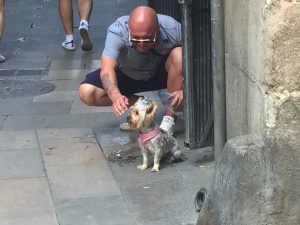
Next, I walked further along Joan de Borbó and then made a right on another major commercial street, Passeig de Colom, whereby I entered el barrio de Born- I know sounds almost like Game of Thrones. If I enter the next neighborhood/kingdom maybe I will see the Lannisters. Born is a trendy neighborhood with high-end shops, restaurants, and nightclubs. The place was hopping at 10:30 pm on a Thursday evening. I next walked to Parc de la Ciutadella, a 70-acrea park that was Barcelona’s first planned green space. The Parc includes Parque Zoologicio (the Barcelona Zoo), one of the most respected zoos in Europe, with an emphasis on educating children about wildlife conservation, el Museo de Geologia (the Museum of Natural Science), Parlamento de Cataluña (the Parliament Building), and several monuments. I wanted to walk around the Park at night. However, after walking through the huge iron gates, a police officer instructed me that the park is closed at night. Alas, the Parc will likely be a running destination tomorrow morning when I take my postponed 8-mile self-guided exercise tour of the city.

Regarding dogs, I saw several Labrador Retrievers, a stunning Borzoi, a German Shepherd, a Lhasa Apso, a Pug (who was at the adjoining table while I was at the Turkish restaurant), and many mixed breed dogs. According to research compiled by Veterinary Management Studies, a division of QVET, and published in ThinkSpain.com, the most popular purebred dogs in Spain are Yorkshire Terriers, Labrador Retrievers, German Shepherds, French Bulldogs, Cocker Spaniels, and Chihuahuas. 52% of dogs are mixed breed, of which the majority are mixed with the same breeds that are popular as purebreds, which is unlike the USA, where a disproportionate amount of shelter dogs tend to be Pit Bulls or Pit Bull crosses. Catalunya has a lower number of mixed breeds than more rural Spanish states. Maltese, Chihuahuas, and Golden Retrievers are the purebred dogs with the most increasing popularity. Small breeds as a whole are becoming more popular, as small dog ownership went up from 47% in 2012 to 49% in 2015, the year of the most recent study.
From my observation, the most notable differences from the USA were the following: 1) I saw zero Pit Bulls or Pit Bull mixes, 2) the dogs, with the possible exception of one, were all very well behaved amidst other dogs and people, regardless of whether they were on-leash or off-leash, and 3) about 1/3 of the dogs were walked off-leash in a busy urban area. Yet, whether on-leash or off-leash, I saw dogs in heel position or slightly ahead or behind, without bolting, pulling, lunging, barking, or jumping. And although people were attentive to their dogs in the street, at the restaurant, and at the beach, nobody baby talked or overly fawned over their animals. Instead, they communicated relaxed, benevolent control- and the animals responded warmly, calmly, devotedly, and obediently.
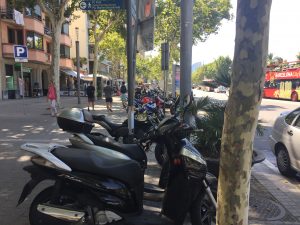
There are two other observations from my nighttime and daytime walks. First, Barcelona is a walking city, at least the Vella District is a walking District. Whereas there was a lot of car traffic during the day, there was little traffic at night. However, the streets day and night were packed with Spanish-and some English, French, German, Czech, Russian, and Arab speaking people. Second, regarding vehicles, the Spanish prefer small. I saw hardly any SUVs. The most popular automobiles in Spain are the SEAT (Sociedad Espanola de Automoviles de Turismo) Ibiza and Leon sedans and the Opel Corsa. Peugots and Citroens are also common. SEAT was founded by the government of Spain in 1950, partnered with Fiat from the 50s until the early 1980s, and has been owned by the Volkswagen Group since 1986. SEAT is a popular brand throughout multiple Western European countries and in Mexico, but does not export to the USA. SEAT Motorcycles and scooters are also very common, along with some Japanese brands, and they are almost all black. Henry Ford would have been proud.
I woke up at 10:30 am, whereby I handled CPT’s emails. Now, before you start calling me a “lazy slob” for waking up at 10:30, remember I got probably only 30 minutes of sleep the night before. Moreover, given Barcelona’s time zone, 10:30 am in Barcelona is 4:30 am in Atlanta. And I don’t know many people waking up at 4:30 am in Atlanta unless they are DJs on “The Morning Zoo.”
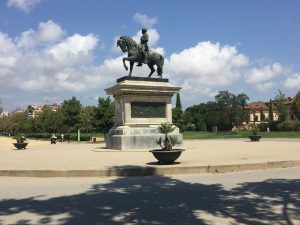
It took me about 90 minutes to finish the CPT emails. Then, at 12 noon (6 am Atlanta time) I went for my “See the City Run.” Usually when I commence a “See the City Run” I plan for 7 to 10 miles, during which I travel the itinerary I plan during my trip. The run helps with spatial association. After just one run, I know where everything is, I can plan efficient logistics, and I get an up close feel for the communities and the people. Typically, I don’t go nonstop during a “See the City Run.” Instead, when visual appeal arises I include breaks to take iPhone photos that encompass a travelogue of the run.
I turned on my Bluetooth headphones, hit shuffle on iTunes, started my Nike Run Club app, put my iPhone in my running armband, and then began the run by progressing north up Passeig de Joan de Borbó until I made a right on Passeig de Colom to head to Parc de la Ciutadella. I figured the cop would let me in during the daytime. Even better news. No guard at the gate. The Parc was beautiful. Many interesting buildings, monuments, and fountains. Now I realize firsthand why Barcelona is known for its architects and its architecture. And this is only my first day truly exploring the city. Much more awaits. In addition, the park had a nice little lake where people could rent boats, grassy areas for people to sunbathe, benches, nice trails, and other amenities, including the Zoo and museums.
However, one misfortune occurred during the run. Upon completing my objectives at the park, I engaged in a sprint from one gate to the next when suddenly my armband broke. The end of life of my armband was not totally unexpected. I noticed a few weeks ago that the band developed a slight tear. Yet, the tear did not seem to progress. Thus, I knew the end was approaching, albeit perhaps not for another few weeks or maybe even months, which made this abrupt ending seem premature. Fortunately, the combination of the armband case and the rubber case around my phone prevented the screen from breaking as the device flew from my arm and crashed upon the concrete. Regardless, subsequently it was not much fun running fast for several miles with a phone flopping in my gym shorts pocket or held in my hand. Thus, I made the executive decision to limit the run to 4 miles.
After finishing at the park, with the phone either in my pocket or my hand- I vacillated as to which option was less bothersome- I ran through trendy Born and then the Gothic Quarter until I reached the Picasso Museum. Wow! The Yogi Berrism “it’s so crowded nobody goes there anymore” came to mind. Except it seemed that everybody wanted to go there. The line for tickets was 90 minutes long. I plan on going there tomorrow or the next day. However, I won’t stand in a 90-minute line. Therefore, I either need to wake up early or buy my tickets online. I wish CPT classes will become as popular while I am alive as Picasso has remained many years after his death, which by the way was 44 years ago, in 1973.
The Museu Europeu d’Art Modern (European Museum of Modern Art) was just 50 yards away and I could have just walked up and bought a ticket. The person at the front desk looked as lonely as Jesse White, “The Maytag Repairman.” I know. An old reference that probably won’t be understood by those under 45. But, they can look up Jesse’s Maytag commercials on YouTube. Then they will understand the humor.
I then headed down Via Laietana toward el Puerto Viejo, which contains L’Aquarium Barcelona and Cinema Maremagnum. I next ran toward the Museu d’História de Catalunya and then back to my AirBnB home.
Given that I hadn’t showered and it was past 1 pm, I decided cleanliness was in order, followed by lunch and a trip to the Museu d’História de Catalunya. In hindsight, I made excellent choices.
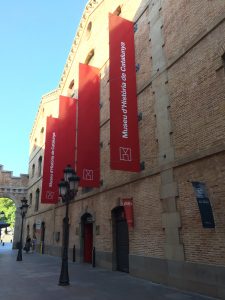
Lunch was an outstanding salad with green and black olives, carrots, radishes, tuna, lettuce, green pepper, and other items, plus an excellent one-person pizza. There was only one negative, a woman 2 tables down lit a cigarette. In my opinion, there is no quicker way to detract from a meal than to inhale secondhand smoke. Barcelona prohibits indoor smoking at restaurants, but allows outdoor smoking. And the percentage of smokers in Europe is far higher than in the USA. Moreover, with the nice summer weather, I would otherwise prefer to eat outdoors. Personally, I would rather smokers instead snorted cocaine or injected heroin, at least then they wouldn’t pollute my airspace. I believe in freedom, like the clothing or lack thereof choices permitted at the beach, but not in the freedom to casually injure the health of bystanders. IMO, persons who smoke at restaurants are committing a battery. Anyway, I was very pleased to leave the chimney woman and her adult daughter, who were smoking around chimney woman’s 2 grandkids, so that I could enter the clean air of the Museum.
For those into data, the CDC says that in 2015 16.7% of adult US men and 13.6% of women (15.1% overall) smoked cigarettes, of which 80.8% smoked every day. Amongst ethnic groups the highest rate was exhibited by Native Americans and Alaska Natives (32.0%) and the lowest rate by Asians (13.3%). Education was also a major factor, as was income. Those earning a GED smoke at a rate of 43.2%, whereas only 6.9% of those with a graduate degree are smokers. There are also regional differences. Utah has the lowest smoking rate by state (9.8%), with Kentucky the highest (28.6%).
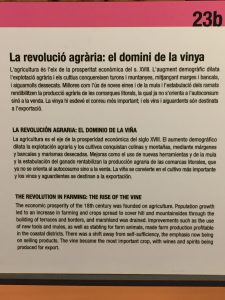
The World Health Organization (WHO) published data from 2015 that listed smoking prevalence by country. Of the 84 countries measured, the USA came in 70th at 17.2% of persons over age 15 smoking cigarettes. Kirbati had the highest prevalence of smokers (52.2%). Greece was 3rd overall and 1st in Europe (42.4%). Spain was 28th overall and 16th in Europe (29.1%). The lowest rates were seen in Iran (11.1%) and India (11.4%).
According to TheTobaccoAtlas.org, a service created by the World Lung Foundation and the American Cancer Society, 29.9% of adult Spanish men and 23.4% of women are smokers. After reading the above data and experiencing the negative tobacco-restaurant event, I made a decision to order my subsequent meals indoors.
Barcelona is the capital of Catalunya, an autonomous state located in the southeast corner of Spain, where the most eastern part touches the French frontera (border). Prior to venturing to the Museu d’História de Catalunya I was aware that Spain is a complex country, with multiple sub-ethnic groups, a history of conquests and kings, and periodic movements for secession by the independent Catalan and Basque people (the Basque region is an autonomous state in northeast Spain). Nevertheless, the Museu provided a thorough historical education that resulted in a superior understanding of why many Catalans emphasize the Catalun language and flag, instead of the Spanish language and flag and why the Barcelona area and south of Spain are such melting pots. Here is a summary of Catalunya’s history:
• The first recorded settlements were in the Middle Palaeolithic Period between 8000 and 5000 BC.
• As the Neolithic Period began Catalonia was slow to adopt fixed settlements with divisions of labor, as the plentiful sylvan setting rewarded a hunter-gatherer lifestyle.
• Metallurgy started in the Eneolithic period between 2500 and 1800 BC. Copper was the first metal used.
• Around 1200 BC the Bronze age started in certain Catalonian areas. Bronze is an alloy comprised of 88% copper and 12% tin. Migration also commenced around this time and certain settlements became larger and more urban.
• Around 700 BC the Iron Age started. Iron is a common, soft metal that when combined properly with carbon and nickel becomes much more durable and resistant to corrosion, which enabled superior tools and weaponry.
• At this time, the majority of those inhabiting Catalonia derived from Iberian backgrounds.
• However, Greek and Carthaginian settlements sprouted during the Second Punic War (218 – 201 BC). The Punic Wars were conflicts between Carthage (present day Tunisia) and the Roman Republic.
• After the Romans defeated Carthage, the Romans brought Catalonia under Roman rule.
• Roman rule remained until the fall of the Western Roman Empire in 476 BC. The approximately 700 years of Roman rule to this day exhibits a strong influence in Catalonian religion, language, and culture.
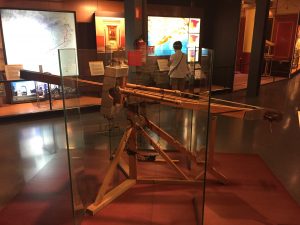
• After the fall of the Roman Empire, Catalonia was conquered by Visigoths, nomadic and militaristic bands of western German people. Despite the atavistic description, the Goths were responsible for implementing an advanced judicial system that lasted until the late Middle Ages.
• In 718 AD Catalonia was conquered by Muslim invaders. There is still a strong Muslim influence in the area, which is facilitated by Spain’s geographic proximity to North Africa.
• In 801 AD the Frankish army expelled the Muslim armies from Catalonia and established heavily militarized counties that created a buffer preventing Muslim expansion into France. Although Muslims were removed from Catalonia in 801, the Moors controlled most of the Iberian peninsula until about 1250 AD.
• A feudal system then spawned, where French counts controlled each county and collected taxes from peasant workers.
• In the 9th century Count Wilfred the Hairy made the title hereditary (just the tile of “Count,” not the hirsute portion) and formed the House of Barcelona. The House of Barcelona ruled the area until 1410.
• The first recognized use of the name Catalonia was in 1117 AD.
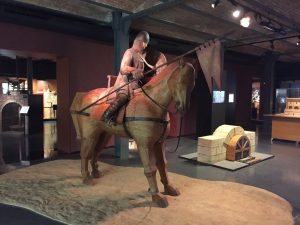
• In 1137 the Count of Barcelona married into the House of Aragon and united Barcelona with the Aragon kingdom located north of Catalonia, in the eastern central portion of Spain..
• In 1258, the King of Aragon renounced his rights and agreed to place the kingdom within the dominion of France’s Carolingian Dynasty.
• During this time Catalonia became a maritime power both militarily and in commerce.
• Between 1347 and 1497 several bouts of the plague caused Catalonia to lose 37% of its population.
• After the area’s king died without any descendants, dissension spawned the Catalan Civil War (1462 – 72), whereby Catalonian constitutionalists revolted against Aragon royalists supporting a new King John II. The royalists won, which reinstituted the feudal system.
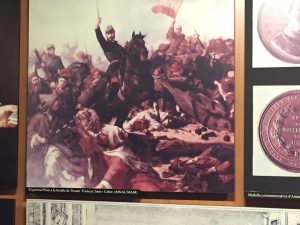
• The first union of Spain occurred in 1469, when the Catholic Monarchs Ferdinand II of Aragon and Queen Isabella of Castile tied the knot. While ruling they expanded Spain’s military might, Western exploration, and worldwide influence.
• In 1478, the Spanish Inquisition, an effort prompted by Ferdinand and Isabella’s desire for an adherent Catholic orthodoxy and perhaps also a financial desire to obtain the lands and monies of heretics, forced either the conversion or expulsion of all Muslims and Jews from Spain, including Catalonia. The Inquisition started in 1478 and peaked in 1492 after the issuance of the Alhambra Decree, which expelled all Jews and Muslims from Spain. The Inquisition was not formally disbanded until 1834, when Queen Isabella II ordered its abolition. At its peak 150,000 non Catholic Spaniards were charged with crimes. For committing the criminal act of practicing non-Catholic religious beliefs, as many as 5,000 people were executed by burning at the stake, in the stocks, or beheading. Many more were taken secretly from their families, imprisoned for years without notifying family members of their whereabouts, tortured, and/or forced to convert. Torture was often used as a method for obtaining a confession of heresy. Torture methods included starvation, contact with burning coals or burning metals, strappado (hanging from the arms in unnatural positions from the ceiling), stretching on the rack, and forcing the subject to drink large quantities of fluids in a method that simulated waterboarding. Rather than risk death, torture, or expulsion, tens of thousands of Jews chose voluntary conversion. In many cases, their families remained practicing Catholics thereafter. Some even became influential within the Church hierarchy. However, others at the risk of death continued to secretly practice Judaism within the confines of their home. Many others chose expulsion, whereby they could openly practice their faith in a new land, usually Eastern Europe, North Africa, or the Middle East. Prior to the Inquisition the Catalonian cities of Barcelona and Girona had thriving Jewish communities, as did the Spanish cities of Toledo and Seville. Interestingly, although the early target of the Inquisition were Jews and Muslims, after the Protestant Reformation that started in 1520, the targets in the 16th century were principally Protestants, especially Lutherans. Secondary targets at that time were witches, blasphemers, bigamists, sodomizers, and Freemasons. In a continued exhibition of the Inquisition’s prolonged expression of religious and ethnic intolerance, during 1609, King Phillip III decreed the Expulsion of the Moriscos, whereby ethnic Muslims who converted previously to Catholicism were expelled anyway- and of course their property confiscated by the Crown. Odiously, the Alhambra Decree that expelled Jews from Spain was not formally rescinded until December 1968! Thus, the Decree endured for almost 500 years!

• Spanish monarchs retained power, but were periodically challenged by Catalan rebellions for independence. A major conflict was the Catalan Revolt of 1640 – 52, where the French temporarily aided the Catalans. At the conclusion, the Spanish monarchy granted Catalan citizens more rights and freedoms.
• The next significant conflict was the War of the Spanish Succession (1702 – 14). The war commenced when Hapsburg King Charles II died without heirs. The major combatants were on one side England, Austria, Holland, Prussia, and Spanish citizens loyal to Aragon and on the other side France, Sicily, Naples, and Spanish citizens loyal to the Crown of Castile. The conflict ended with the signing of the Treaty of Ultrecht and the Treaty of Rastatt. At the conclusion Charles VI owned an expanded Hapsburg Empire. However, Philip V, a relative of the French monarchy, conquered Barcelona and consolidated the Spanish Castile crown.
• During the latter part of the 18th century Catalonia experienced increased industrialization.
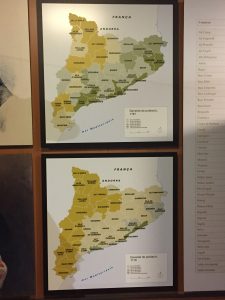
• The Napoleonic Wars (1803 – 1815) impacted Catalonia. In 1808 Napoleon invaded Portugal and Spain and declared his brother, Joseph Bonaparte, as King of Spain. However, in 1814, after 6 years of fighting, Portuguese and Spanish citizens bolstered with British support repelled the French invaders.
• The Carlist Wars, a series of 3 conflicts from 1833- 1840, 1846 – 1849, and 1872 – 1876, were Spanish civil wars where followers of Infante Carlos (Carlos V) and his descendants fought for a unified Spain and Catholicism, whereas opponents believed in religious liberalism and regional republicanism. The wars started upon the death of Ferdinand VII. His 4th wife Maria Christina then ascended the throne. She had liberal leanings that encouraged industrialization, social freedoms, and anti-clericalism. However, the conservative brother of Ferdinand VII, Carlos V, wanted the throne and he had very different political and religious leanings, including a belief in a strong and autocratic monarchy and strict adherence to Church doctrine. Thus, the Carlists fought the Christinos on 3 separate occasions, with the Christinos winning. As a result Catalonia became more industrialized and the influence of the church diminished.
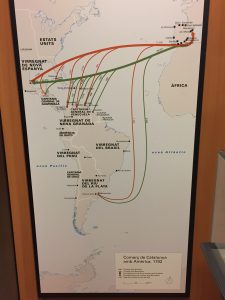
• During he latter part of the 19th century an increasing amount of Catalonians emphasized the Catalan language and sought political autonomy. The Catalan language is known as a Vulgar Latin Romance language. Catalan is the national language of Andorra, and the co-official language of Catalonia, the Balaeric Islands, and Valencia. The language appears as an amalgam of Spanish, Latin, Italian, and French influences.
• Upon the onset of the Second Spanish Republic, Catalonia achieved its first Statute of Autonomy in 1931. The Statute of Autonomy appointed a government system, the Generalitat of Catalonia, that included parliament and courts and Catalonia’s first leader, Francesc Maciá, who instituted increased social programs and an emphasis on Catalonian language and culture.
• The Spanish Civil War occurred from 1936 – 1939. Republicans loyal to the democratic, modern Second Spanish Republic fought against Carlist and clerical sympathizing conservative Nationalists led by General Francisco Franco. After conquering Catalonia in 1939, Franco, a fascist supported by Nazi Germany and Italy, won the war and ruled Spain with a dictatorial iron hand from 1939 until his death in 1975. The war is notable for its atrocities and brutality, as well as for the spawning Franco’s 36-year dictatorship. The war cost the lives of 240,000 soldiers and citizens. Post-war executions resulted in the additional deaths of anywhere from 50,000 to 150,00 Republican loyalists, many of whom were Catalans. Moreover, between the years of 1939 to 1947 anywhere from 360,000 to 500,000 former combatants, dissidents, and homosexuals were incarcerated in 190 forced labor concentration camps.
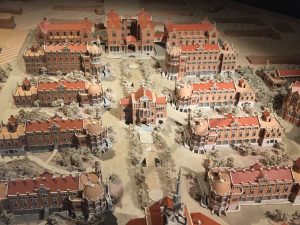
• Franco’s dictatorship forcibly suppressed the Catalan language and culture, imposed Catholicism upon the people, and instituted a mandatory parochial education system.
• In the latter 1950s, Franco’s regime relaxed some of the legislation banning Catalonian expression.
• The mass destruction of property from the war combined with an international trade embargo and general isolation devastated the Spanish economy.
• However, the Spanish economy improved in the 1960s, which included immigration and manufacturing investment in Catalonia and a burgeoning tourism industry.
• After Franco died in 1975, King Juan Carlos, Franco’s chosen successor, allowed more liberal laws and state autonomy.
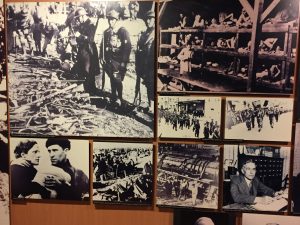
• In 1978, Catalonia approved a democratic Spanish constitution that restored the Generalitat and created an autonomous state.
• In 1992 Barcelona hosted the Summer Olympics.
• In 2006, Catalonia approved a revised Statute of Autonomy of Catalonia. The declaration was unpopular in Spain. Ultimately, in 2010 the Constitutional Court of Spain invalidated many of the articles, including those covering a Catalan system of justice and Catalan as the primary language.
• Subsequently, many Catalonians sought independence from Spain.
• In 2015 Catalan legislators approved a plan for secession, which was suspended by the Spanish Constitutional Court. The plan called for secession in 2017. Many in Catalonia are still pushing for secession and an independent state that highlights the Catalonian language and culture.
I found the Museum highly informative. I highly recommend the Museu d’História de Catalunya to any visitor who appreciates history and culture. However, on the negative side, for many of the periods, the detailed placards were more stimulating than were the visual displays. That works fine for the nerdy-type like me who read everything. Yet, for someone that is more visual and cursory the Museum is likely to provoke boredom, especially if the person is not a history buff.
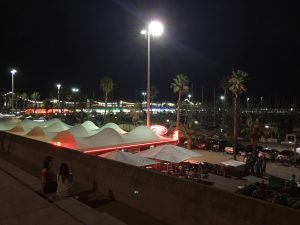
I will also make one additional positive note about the Museum, each card was in Catalan, Spanish, and English. Although I can read Spanish fairly well, I appreciated the available English translation. I wonder why museums in the USA rarely provide foreign translations on the placards. Expressing more courtesy to the language issues of foreign visitors would likely help foster increased tourism patronage and revenues.
I stayed at the Museu d’História de Catalunya until near closing. Then I headed back to my friend Nico’s home to respond to CPT emails. Next, it was time to eat dinner. I elected to eat along the beach. Therefore, I walked about 2 blocks from my AirBnB, reached the boardwalk, and headed east.
By the Port Olimpic, the site of the famous whale sculpture, I stopped to eat at Gino’s, a quality chain of Italian restaurants in Spain. I had some excellent fried zucchini as an appetizer and a spinach pasta as the main course. The pasta was excellent, too, until… the empty table by me became occupied by 2 smokers. It was at this point that I decided all upcoming meals will either be eaten en la interior o lleva a mi casa (indoors or carried home). Never again will I make the mistake of assuming a nice table outdoors in Barcelona will remain a nice table. Mind you, I am not only cognitively intolerant of smokers, I am physically intolerant of their smoke. I started coughing after this meal, whereas I was not coughing previously.
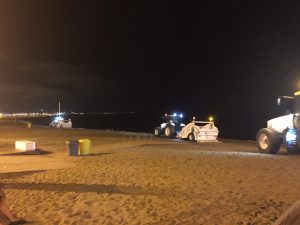
After eating and while coughing I walked to the most eastern of Barcelona’s beaches, Llevant, and then turned westward to reach the most western beach, Sant Sebastia. The total walk encompassed more than 5 miles. The walk allowed me to get a good feel for the available beach areas, each of which has a slightly different culture. Some are principally family beaches, whereas others are principally nude and/or topless, gay, old, young, tourist, or native.
While night walking I observed a number of dogs walking or running alongside their owners, who were walking, running, roller blading, or bicycling. Most of the dogs were off-leash and all except one were well behaved, where the dogs ignored other people and dogs while remaining on task. There was one notable, albeit friendly exception, where a lab/hound mix paid attention to everybody but its owners, an old couple that walked very slowly. Maybe their pace was boring to the dog.
I am still postulating why the off-leash dogs in Barcelona appear saliently better behaved on average than the dogs in Atlanta. I have some theories. First, although the people obviously love their dogs and spend time with their dogs, they don’t baby their dogs either physically or verbally. Thus, the dog learns to be more placid and the dog receives a communication style that is a more effective human-dog leadership communication style. Second, since the Barcelona apartments are so small and don’t have backyards, the owners must take their dogs outside for socialization, exercise, and toileting. Whereas, American dogs are often left alone in the backyard for “exercise” and toileting, Barcelonan dogs see new people and dogs several times per day every day. Thus, they are better socialized and acclimated. Seeing or meeting people and dogs is not as novel. Therefore, the dogs are more calm. In only a few circumstances did I see or hear owners verbally communicate commands. Rather, the dog independently remained tranquil and obedient, without much overt control on the part of the handler. Granted, maybe there was extensive training prior to allowing the dogs off-leash. Yet, compared to the socialization component, the training component was not as conspicuous during my observations.

I would say that the dogs were well behaved, but not necessarily well trained. By the preceding, I mean that I didn’t see spiffy high caliber attention heeling or rapid, straight, sits or downs. Instead, what I observed were dogs acting with decorum without the necessity of pervasive command management.
I walked until about 1 am. I was impressed with the crowds of people out and about at 1 am. New York is not the only city that never sleeps. There were people going to beachside nightclubs. People hanging out. Families walking. Couples walking. Friends walking. Joggers. People, couples, and families spending time with their dogs. And women walking and jogging alone without seemingly any fear. My guess is that few Atlanta women would walk alone in the city at 1 am, whereas in Barcelona I saw a number of women walking or exercising alone past midnight.
However, even if the City of Barcelona is still up it is time for me to get some sleep. Plus, this cough is getting worse. I just hope I can fall asleep between coughs.
© Copyright Mark Spivak and Comprehensive Pet Therapy, Inc., July 2017, All rights reserved.